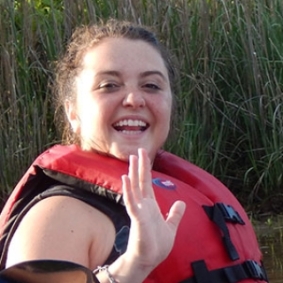Eight students will be presenting the summer work at the Ocean Sciences Meeting in March 2022!
Annie Nyffeler, Nebraska Wesleyan University
Class Year:
2015Mentor:
Thomas Miller, Ph.D.Project Title:
Climate Change Effects on Respiration Rates of Blue Crab (Callinectes sapidus) from the Patuxent River, Chesapeake Bay
Abstract:
A rise in atmospheric CO2 induces a greenhouse effect that also causes ocean temperatures and CO2 levels to rise. These environmental changes may represent an additional energetic cost for blue crabs because they rely on the concentration of CO2 in the water to deposit calcium carbonate in their shells. We conducted a respiration experiment to measure the effect of climate change on crab metabolism. Crabs were collected from the Chesapeake Bay and exposed to different heated and acidified conditions. After crabs had been exposed to the environmental conditions in the chambers for two molts, they were placed in respiration chambers to measure rates of oxygen consumption. Results indicated different trends in respiration rates between the treatments, although the patterns were not statistically significant. Crabs exposed to higher temperatures showed elevated respiration rates, while crabs exposed to high CO2 demonstrated decreased respiration rates. The two factors of climate change (high temperature and high CO2) did not demonstrate the highest respiration rate, but rather the crabs exposed to high temperatures and ambient CO2 showed the highest mean respiration rate. These data suggest that crab metabolism may not change as much as expected due to climate changes.
Location:
Chesapeake Biological LaboratoryPresentations:
Nyffeler, A.* and T. Miller. 2016. Climate change effects on respiration rates of blue crab (Callinectes sapidus) from the Patuxent River, Chesapeake Bay . Ocean Sciences Meeting, New Orleans, Louisiana .




